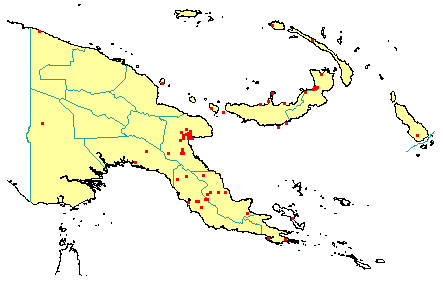
in PNGplants database
PNGTreesKey – Dysoxylum parasiticum (Osbeck) Kosterm. |
Barry Conn (NSW) & Kipiro Damas (LAE).
Guide to trees of Papua New Guinea
Copyright held by the authors, National Herbarium of New South Wales, and Papua New Guinea National Herbarium
Reinwardtia Vol. 7: 247 (1966)
Other Literature: D.J. Mabberley & A.M. Sing, Flora Malesiana, Series 1 76-81 (1995) Fig. 11.
Family: Meliaceae
Dicotyledon
Timber Group: Minor hardwood
Field Characters: Large canopy tree (up to 27 m high, rarely up to 36 m) or Small sub-canopy tree (up to 20 m high); Bole cylindrical (up to 45 cm diam., rarely to 60 cm); crooked (bole up to 6 m long); buttresses buttresses present (buttresses up to 1.5 m high) or buttresses absent; spines spines absent; aerial roots aerial roots absent; stilt roots stilt roots absent; Bark pale yellow, grey, or greyish brown, slightly rough or almost smooth, scaly or flaky or slightly pustular, lenticels elongated vertically or rarely lenticels irregular; Subrhytidome (under-bark) dark yellow; less than 25 mm thick, 15.0-20.0; bark blaze consisting of one layer; strongly aromatic; unpleasant or onion-like; outer blaze yellow or pale brown, rarely speckled or with stripes (orange), granular with splinters; inner blaze yellow or pale brown, rarely speckled or with stripes (orange), granular with splinters; bark exudate (sap) present, colourless, not readily flowing (spotty), colour changing on exposure to air or colour not changing on exposure to air, to brown, not sticky; terminal buds not enclosed by leaves.
Indumentum: Complex hairs absent; stinging hairs absent; mature twig indumentum (hairs) present, hairs sparse.
Leaves: Leaves spaced along branches, spiral (leaves occurring singly at a node and arranged spirally up the branchlet), compound (a leaf made up from two or more leaflets); petiole present, not winged, attached to base of leaf blade, not swollen; leaves pinnate (unbranched with more than three leaflets); petiolule not swollen; rachis present, absent, absent; leaves with a terminal leaflet (the number of leaflets odd - imparipinnate), broadest at or near middle, broadest below middle, or equally broad throughout much of length, 16.0-20.0 (-28.0) cm, 5.0-7.0 (-8.0) cm, leaflets opposite (slightly subopposite), asymmetric, terminal developing leaflet buds straight; venation pinnate, secondary veins open, prominent, intramarginal veins absent; leaves lower surface pale green, upper surface green, indumentum (hairs) present (hairs brown), indumentum (hairs) dense or sparse; absent; domatia absent; stipules absent.
Flowers: Inflorescence on the trunk or branches, flowers on an unbranched axis, cones absent; flowers bisexual, stalked, flowers with many planes of symmetry, 12.0-16.0 mm long, diameter small (up to10 mm diam.) (5-9 mm diam.); perianth present, with distinct sepals and petals whorls, inner perianth white; 5, some or partly joined; stamens 10, absent (appearing absent) or present, joined (forming staminal tube), joined to the perianth; ovary superior, carpels joined (when more than one), locules 5; styles solitary, 1.
Fruits: Infrutescence arranged on unbranched axis, fruit 30.0-40.0 mm long, brown, not spiny, fleshy (leathery), simple, dehiscent, capsule; seeds 2-5, much more than 10 mm long (15-20 mm long), not winged, narrow (longer than wide), seed more than 10 mm diam. (up to c. 15 mm diam.).
Distribution: West Sepik, East Sepik, Madang, Morobe, Western Highlands, Eastern Highlands, Southern Highlands, Western, Gulf, Central, Northern, Milne Bay, New Britain, New Ireland, Manus & Bougainville.
 | Botanical records in PNGplants database |